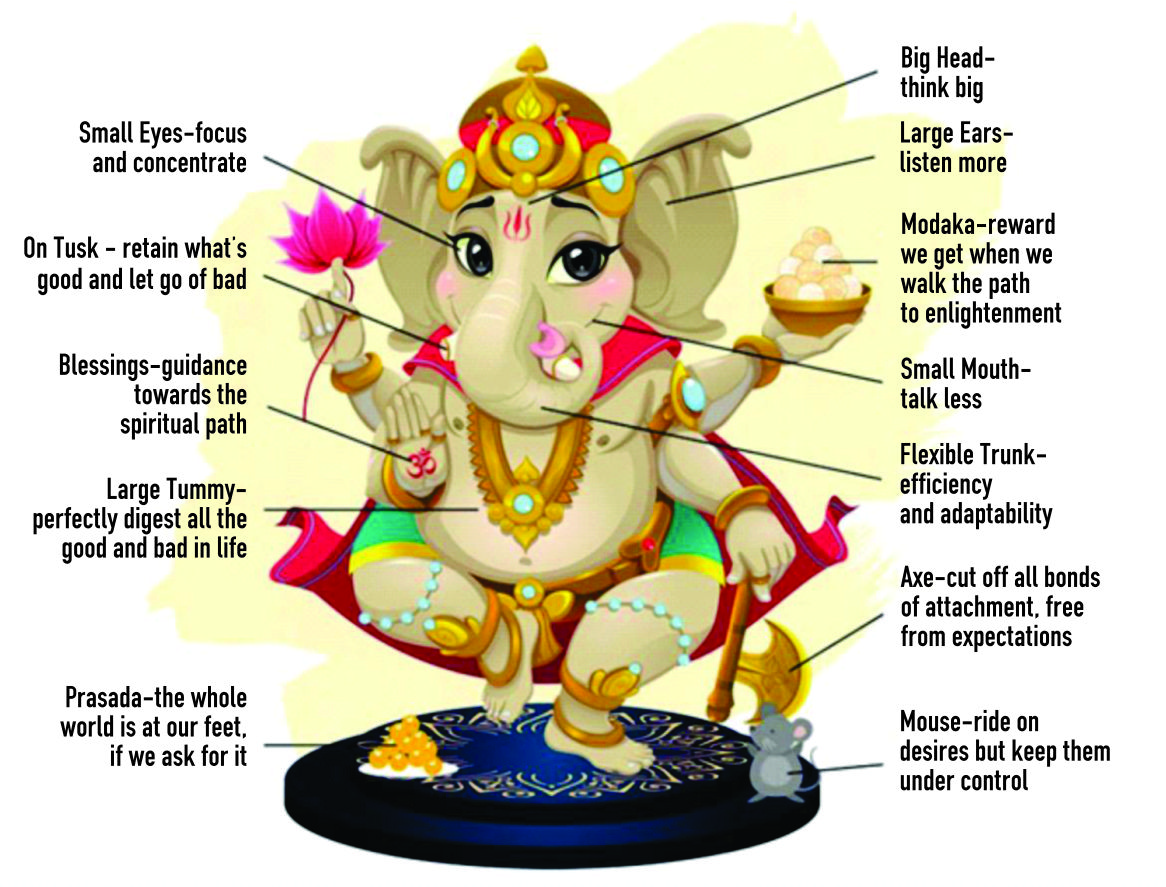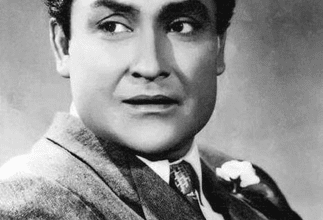General
VINAYAKA…By RASHIKA KUMARI SINGH
INVOKING VINAYAKA IN YOU
With pandals all set boasting tall idols of Lord Ganesha, September comes with a festive hindu tradition of bringing bappa home. But is this festival all about merely invoking, remembering and praising a God? Why not take inspiration from Ganesha and imbibe his powers and qualities in our own life? I have put together 10 lessons from the life of Vinayaka for us all to make this festival more successful!
- The symbolism of his birth: Parvathi carved out a baby from the dirt of her skin symbolizing that this body is made of nothing but mud, this is called body consciousness. The body consciousness (Ganesha’s body) is unable to recognise the Lord (Shiva) as his father. Shiva cutting off the head (and not killing) of Ganesha, symbolises how on the spiritual path, God first cuts off our head filled with pride and ego and replaces it with the head of Wisdom (elephant head). He does so without compromising emotional intelligence because the brain of an elephant is heavier than a man’s and it has more complex folds than all animals except whales.
- Staying true to our duties: The story of beheading of lord Ganesh teaches us that our duty and responsibility is above everything else. He readily sacrificed His head in order to fulfil the responsibility which His mother gave Him. He performed what Krishna called Karma Yoga. After replacing his head, the persistence and courage inspired the gods who accepted Ganesha the leader of all beings. We should not fear any obstacles in our path. If we value the trust placed in us and perform our duties wholeheartedly, we will be rewarded with the respect and love that we deserve.

- Work Smart: Most of us often crib about having limited things in life. But the story of the Ganesha and Kartikeya race teaches us how we can make the best use of the limited resources that we have. Kartikeya left immediately on His peacock. Ganesha was in a fix as He couldn’t do the same with His mouse. So, Him going around his parents. who for him were His world, teach us the power of quick wit which made Him the winner even with limited resources in hand. Using a spiritual lens, we also learn that it is pretty much impossible to go around the world but one who goes around the knowledge of the Supreme, is the sole conqueror of at least his own world.
- Dedication towards our Duties: The story of lord Ganesh writing Mahabharata while sage Vyas dictated it teaches us the power of will and dedication. It is said that in between of the dictation, Lord Ganesha’s writing quill breaks due to continuous writing, In order to keep his promise of writing without a pause, Lord Ganesha, without any hesitation, breaks half of his tusk and uses it to write This shows why Lord Ganesha is called the remover of obstacles. He teaches us the importance of keeping one’s word. All we require is a committed mind and determination if we have the right mindset, there is nothing we cannot achieve.
- A great teacher: As the story goes, when Lord Kuber, blinded by the pride of his wealth, invites Lord Shiva and Parvathi to his abode for a feast, Lord Ganesha goes to the feast instead of his parents to teach Lord Kuber an important lesson. He smashes Lord Kuber’s pride by eating every possible item available at his abode and still feeling hungry. Unable to satiate Ganesha’s hunger, Kuber asks Parvathi for help, who sends a small bowl of rice cooked with love for Ganesha to eat. That small bowl of rice made with love satiates his hunger over all the entire kingdom’s food which was presented with pride. He teaches Kuber a lesson and smashes his pride, all so with grace and wit!
- Forgiveness is the ultimate virtue: The lover of food and desserts, Lord Ganesha was returning home after having a hearty meal, when he stumbled and rolled over on his belly. The Moon saw it from high above, and burst into a cynical laughter that miffed Lord Ganesha, and compelled him to curse him. He cursed the moon to disappear from the sky completely, while he begged for forgiveness. Ultimately, the generous Lord Ganesha gave in to his requests, but since he couldn’t revoke the curse, he reduced the disappearance span of the moon from the sky to one day. Lord Ganesha’s story explains how anger gets to the best of us, but it is our power to overcome it that makes us a better human being.
- Humility & Respect for Other Beings: After defeating Gajasur the demon who troubled the lord, Ganesha still accepted him as his vehicle. The huge God rides a pury mouse It shows that the Lord doesn’t discriminate and respects even the tiniest creature, even those who have greatly caused misdeeds but are repenting. This trait is extremely important for us to imbibe, to become a bigger person. Only then can we get a respectable position in life.
- Always uphold your self-respect: Legend has it that once, all the gods and goddesses left Lord Ganesha in-charge of the Swargaloka, as they left with Lord Vishnu’s marriage procession headed towards Goddess. Laxmi’s abode. Lord Ganesha was tricked into taking care of Swargaloka, because the other deities were embarrassed by his physical appearance and massive diet. On getting to know the truth, Lord Ganesha wanted to avenge himself, and devised a clever plan that would make them realise his importance. Ganesha sent his rat vehicle, Gajasur, to dig up the roads that led to Goddess Laxmi’s abode, and he obeyed. As expected, the deities couldn’t proceed further and took help from a farmer who was crassing by the road. He pulled out the carriage stuck in the road in the first attempt after chanting Lord Ganesha’s name explaining how Lord Ganesha inspired him as Vighna-harta (remover of obstacles). This made the deities realise that there’s more to a being than his physical appearance. Never let anyone undermine your abilities, or your physical appearance cloud people’s judgement of you.
- River Kaveri’s Origin: Sage Agastya wished to create a river that would benefit the people staying in the southern lands to which the Gods heeded by presenting him with a small bowl containing water which would give birth to a river wherever he would pour the bowl, the river would originate from there. Agastya decided to create the origin beyond the mountains of Coorg and proceeded to travel there. On the journey, he got tired and began looking for a place to take some rest. Just then, he came across a small boy who was standing alone. He requested him to hold the pot of water while he went and relieved himself. When he came back, he saw the pot was on the ground and a crow was drinking from it. He shooed away the crow, who flew away but not before tipping the pot on the ground which resulted in the birth of Kaveri. The pot was set aside by the boy who was none other than Ganesha, as he knew it was best the river originated from here itself. You only have control over your Karma, everything else that happens, happens for the universal good and justice! Do not get too materially attached to your plans as it’s always God’s plans that triumph.
- Love for fellow earthlings: Ganesh was a mischievous kid, who once came across a cat and proceeded to mess around with it He picked up the cat and threw it on the ground, pulling its tail and having fun with it, while the cat meowed in pain, Ganesha failed to notice it and played around until he was tired and then camel back home. To his astonishment and horror, he saw Parvathi lying on the ground, wounded and bleeding. She proceeded to explain how she was the embodiment of prakriti and any harm to nature was a harm directed to her. His unfair treatment to the animal not only caused prakriti pain, it came back as a “Karmphal” on his mother. Hence, we should be very loving to every earthling around us for we are all one family. It also teaches us a lesson of karma, what goes around, comes around!
With Ganesha’s idol, make sure you bring his qualities and abilities home too and immerse them in the depths of your existence. Ganapati Bappa Morya!!!






